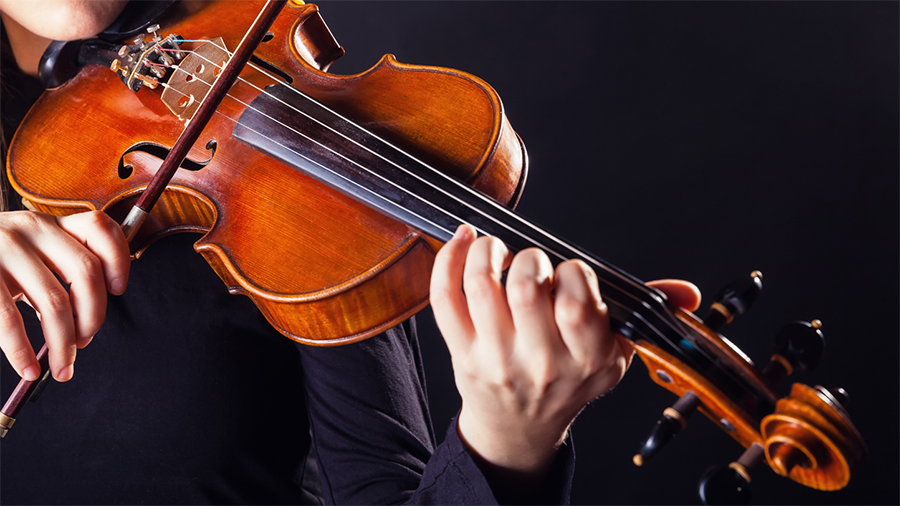The violin, the most commonly used member of the modern string family, is the highest-sounding instrument of that group. Its four strings are stretched over a high arched bridge that permits the playing of one or two strings at a time, as well as the nearly simultaneous sounding of three or four as chords. The overall length of the violin averages about 60 cm (23.5 in), whereas the sounding length of the strings, from the bridge to the nut at the end of the fingerboard, is about 32 cm (12.75 in). The instrument is held on the left side of the body, while the right-hand holds the bow. The wider end of the instrument is placed between the player’s left shoulder and chin, while the left hand encircles its neck, the fingers stopping the strings to produce the various pitches. The sound is produced by drawing the bow across the strings to make them vibrate, or by plucking the strings (PIZZICATO).
The range of the violin extends from G, the lowest open string, upward nearly four octaves. The strings have tuned a fifth apart at G3(196 Hz), D4, A4, E5(659.3 Hz). Many consider that violin making reached its pinnacle in the work of Antonio Stradivari and Guiseppe Guarneri in the 18th century. Although the basic construction of the violin has been long established, the subtle variations which make an outstanding violin are the stuff of legend.
The Indian Violin: The South Indian violin is almost identical to the Western violin, but differs from it in tuning and playing the position. It is traditionally played, sitting cross-legged, with the scroll placed on the artist’s right ankle, the back of the violin resting on the artist’s left shoulder (collarbone, or chest), thus giving the performer an unencumbered left hand with which to play Indian Musical Ornamentations such as the Gamaka.
Tuning of the instrument is as follows: tonic, dominant, tonic (octave higher) and dominant (octave higher), from the fourth top the first string respectively, the tonic being variable. The Karnatic violin is a must as a melodic accompaniment, in both instrumental (except for Nagaswaram) and vocal concerts.
BaluswamyDikshitar was responsible for introducing and adapting the violin to Indian music in the early 19th century. Within a short time, it replaced other instruments like the veena, which were used to accompany vocal performances and became the primary accompanying instrument in the Karnatic tradition. This was a welcome precedent, and it helped other accompanying instruments like the flute to gain prominence too.
Times have seen the Indian violin rise to an international status as a solo instrument on par with the Western violin; adapted and featured as a solo instrument with major symphony orchestras and chamber groups (both classical and neo-fusion). This has opened up a wide range of possibilities and new avenues on the international scene for the Indian violin. Professor V. Lakshminarayana was a torchbearer in introducing fabulous, masterful, original techniques in playing the violin. These techniques, when learnt and practised, can enable one to have a complete mastery over the instrument while maintaining the ornamentation, which is essential to the Indian tradition. This is the most important factor that has contributed to bringing the violin to its present status. Besides this, he also introduced new, innovative concepts in the art of solo, duet and trio violin paying in Indian music.





0 Comments